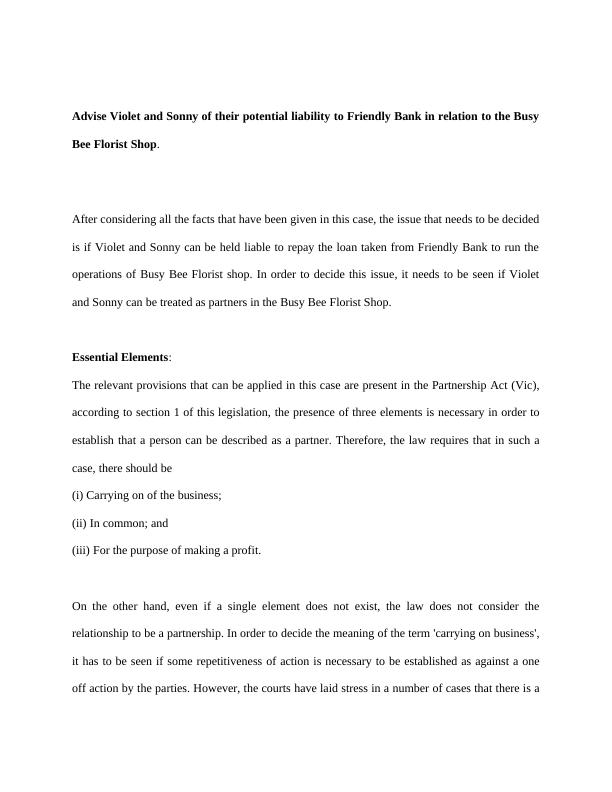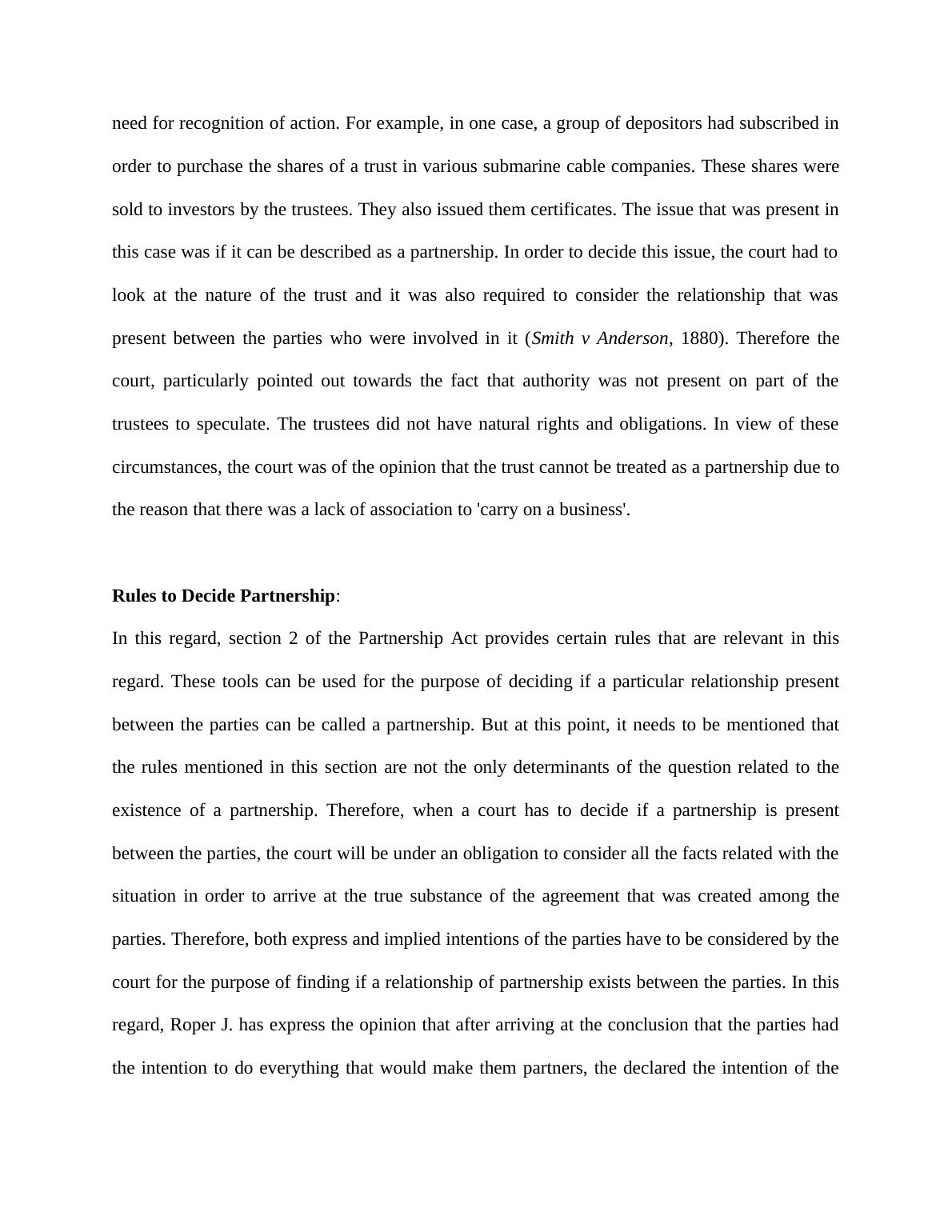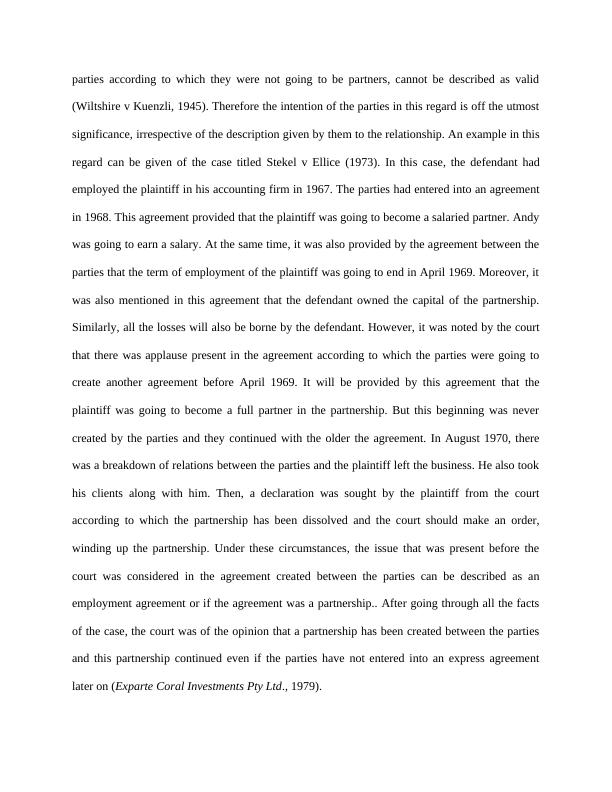A Possible Liability to Friendly Bank in Relation to the Busy Bee Florist Shop
Added on 2020-04-07
7 Pages2399 Words158 Views
Advise Violet and Sonny of their potential liability to Friendly Bank in relation to the BusyBee Florist Shop.After considering all the facts that have been given in this case, the issue that needs to be decidedis if Violet and Sonny can be held liable to repay the loan taken from Friendly Bank to run theoperations of Busy Bee Florist shop. In order to decide this issue, it needs to be seen if Violetand Sonny can be treated as partners in the Busy Bee Florist Shop. Essential Elements:The relevant provisions that can be applied in this case are present in the Partnership Act (Vic),according to section 1 of this legislation, the presence of three elements is necessary in order toestablish that a person can be described as a partner. Therefore, the law requires that in such acase, there should be (i) Carrying on of the business; (ii) In common; and (iii) For the purpose of making a profit. On the other hand, even if a single element does not exist, the law does not consider therelationship to be a partnership. In order to decide the meaning of the term 'carrying on business',it has to be seen if some repetitiveness of action is necessary to be established as against a oneoff action by the parties. However, the courts have laid stress in a number of cases that there is a

need for recognition of action. For example, in one case, a group of depositors had subscribed inorder to purchase the shares of a trust in various submarine cable companies. These shares weresold to investors by the trustees. They also issued them certificates. The issue that was present inthis case was if it can be described as a partnership. In order to decide this issue, the court had tolook at the nature of the trust and it was also required to consider the relationship that waspresent between the parties who were involved in it (Smith v Anderson, 1880). Therefore thecourt, particularly pointed out towards the fact that authority was not present on part of thetrustees to speculate. The trustees did not have natural rights and obligations. In view of thesecircumstances, the court was of the opinion that the trust cannot be treated as a partnership due tothe reason that there was a lack of association to 'carry on a business'.Rules to Decide Partnership:In this regard, section 2 of the Partnership Act provides certain rules that are relevant in thisregard. These tools can be used for the purpose of deciding if a particular relationship presentbetween the parties can be called a partnership. But at this point, it needs to be mentioned thatthe rules mentioned in this section are not the only determinants of the question related to theexistence of a partnership. Therefore, when a court has to decide if a partnership is presentbetween the parties, the court will be under an obligation to consider all the facts related with thesituation in order to arrive at the true substance of the agreement that was created among theparties. Therefore, both express and implied intentions of the parties have to be considered by thecourt for the purpose of finding if a relationship of partnership exists between the parties. In thisregard, Roper J. has express the opinion that after arriving at the conclusion that the parties hadthe intention to do everything that would make them partners, the declared the intention of the

parties according to which they were not going to be partners, cannot be described as valid(Wiltshire v Kuenzli, 1945). Therefore the intention of the parties in this regard is off the utmostsignificance, irrespective of the description given by them to the relationship. An example in thisregard can be given of the case titled Stekel v Ellice (1973). In this case, the defendant hademployed the plaintiff in his accounting firm in 1967. The parties had entered into an agreementin 1968. This agreement provided that the plaintiff was going to become a salaried partner. Andywas going to earn a salary. At the same time, it was also provided by the agreement between theparties that the term of employment of the plaintiff was going to end in April 1969. Moreover, itwas also mentioned in this agreement that the defendant owned the capital of the partnership.Similarly, all the losses will also be borne by the defendant. However, it was noted by the courtthat there was applause present in the agreement according to which the parties were going tocreate another agreement before April 1969. It will be provided by this agreement that theplaintiff was going to become a full partner in the partnership. But this beginning was nevercreated by the parties and they continued with the older the agreement. In August 1970, therewas a breakdown of relations between the parties and the plaintiff left the business. He also tookhis clients along with him. Then, a declaration was sought by the plaintiff from the courtaccording to which the partnership has been dissolved and the court should make an order,winding up the partnership. Under these circumstances, the issue that was present before thecourt was considered in the agreement created between the parties can be described as anemployment agreement or if the agreement was a partnership.. After going through all the factsof the case, the court was of the opinion that a partnership has been created between the partiesand this partnership continued even if the parties have not entered into an express agreementlater on (Exparte Coral Investments Pty Ltd., 1979).

End of preview
Want to access all the pages? Upload your documents or become a member.
Related Documents
Partnership Act Assignmentlg...
|5
|2088
|43
The Busy Bee Florist Shop and Friendly Banklg...
|7
|2098
|442
Business & Company Law: Assignmentlg...
|10
|2222
|169
Partnership Business and Creditorslg...
|7
|2261
|182
Case Study on Partnership- Reportlg...
|7
|2142
|405
Company Law Case Study : Assignmentlg...
|10
|2666
|48
